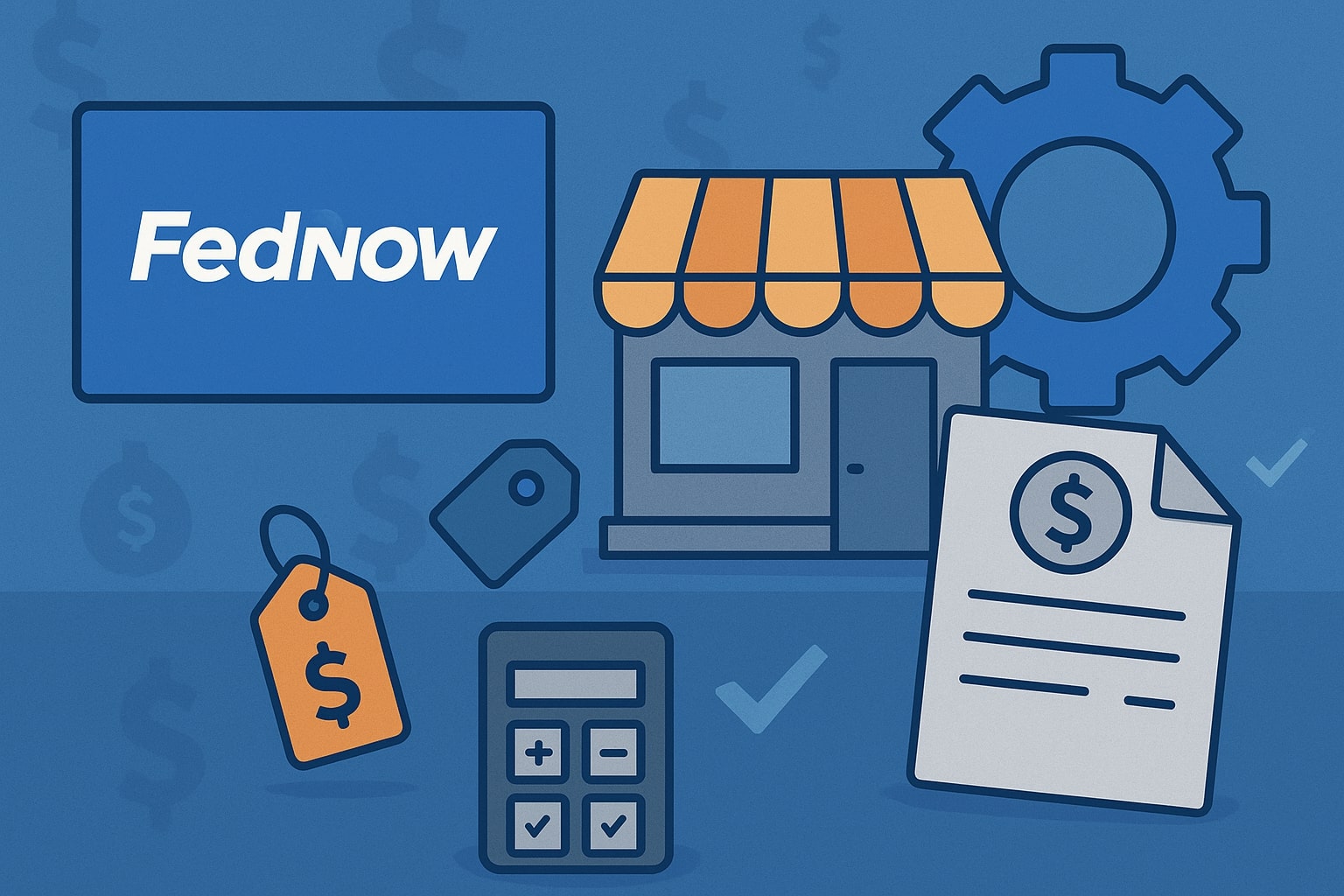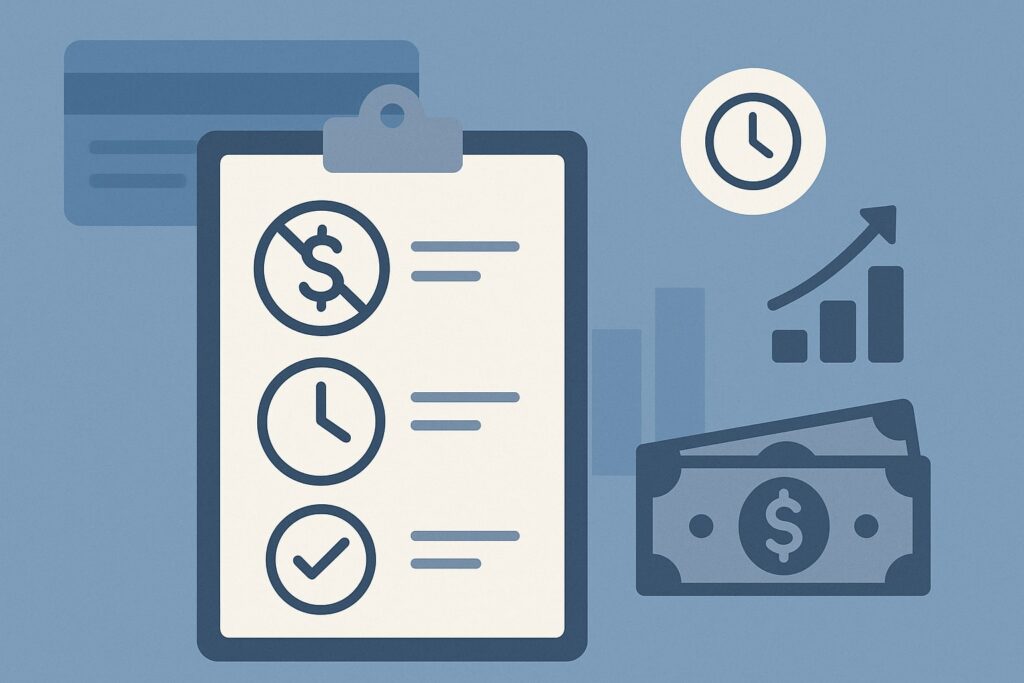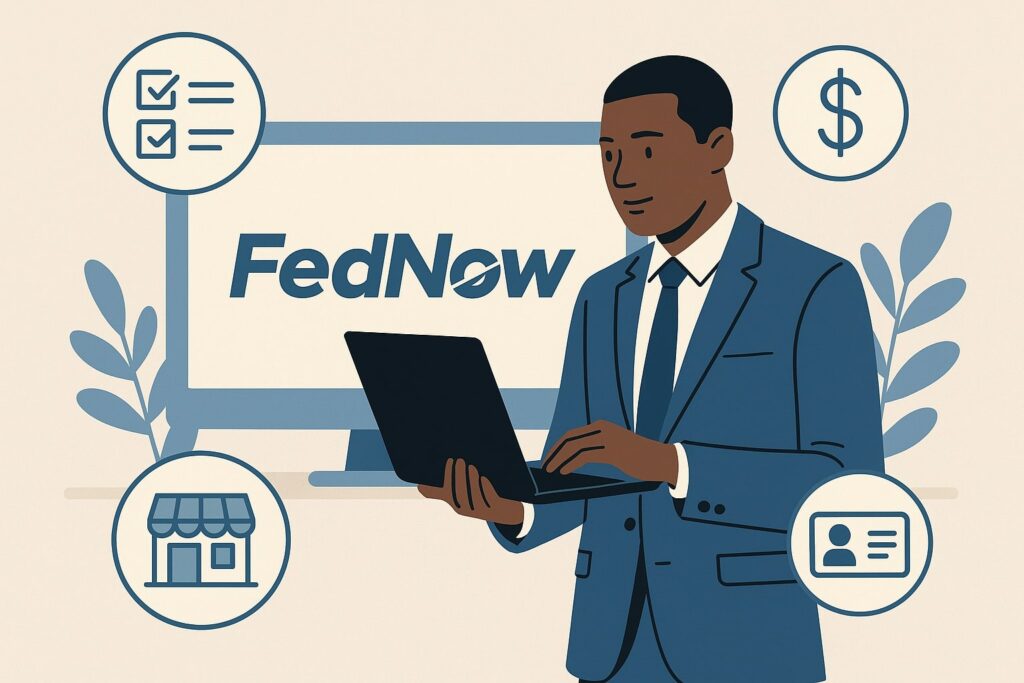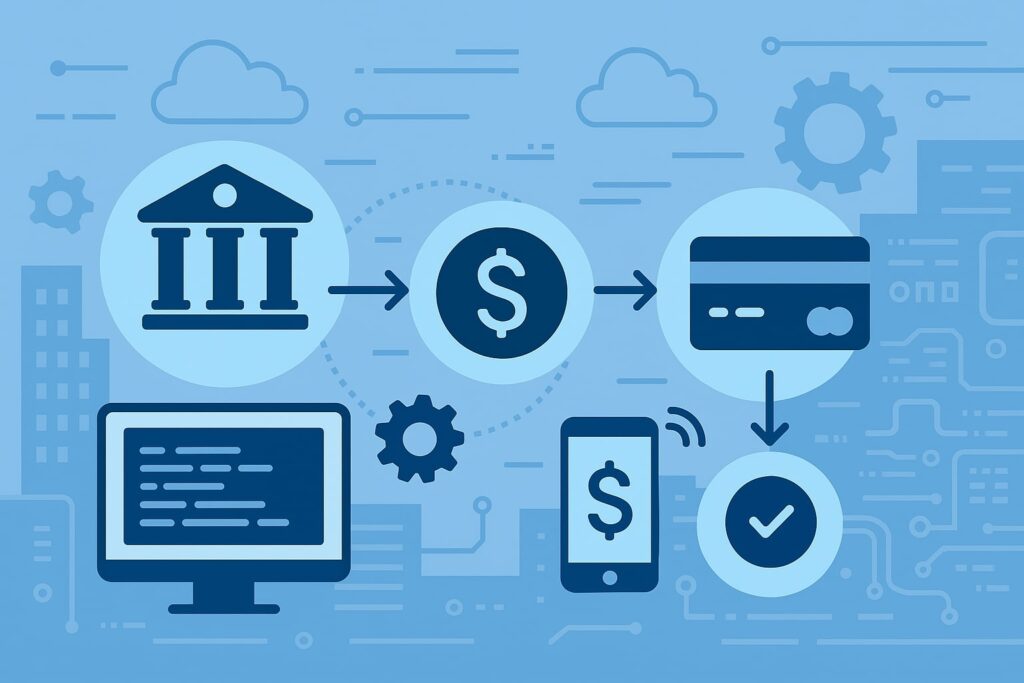
By p2pbusinesspayments October 26, 2025
FedNow is the Federal Reserve’s instant payments infrastructure that lets participating banks and credit unions move money in real time, 24x7x365. Unlike card networks or ACH (which may batch and delay settlement), FedNow settles between financial institutions in seconds, giving recipients immediate access to funds.
For businesses, that means faster payouts to vendors and workers, better cash-flow control, and fewer surprises caused by delayed deposits.
Technically speaking, FedNow is an interbank real-time gross settlement (RTGS) system with integrated clearing, designed to operate continuously—including weekends and federal holidays—so you aren’t constrained by banking hours.
At the end of every day, balances are reflected on Federal Reserve accounting records, but individual payments clear and settle in real time as they happen.
FedNow is not a consumer app and you don’t connect to it directly as a business. Access comes through your financial institution (or a service provider your bank uses). Your bank integrates to the Fed’s rails and then exposes FedNow features to you inside corporate online banking portals, APIs, or treasury platforms.
In practice, you’ll see features like “instant transfer,” “send now,” or “request for payment” (RFP) in your bank’s interface; the FedNow brand may not even appear on your screen because it’s the high-speed highway beneath your bank’s experience.
Because FedNow is rails, your experience—and your business results—depend on which participating bank or provider you choose and which options they enable (receive only, send + receive, RFP, APIs, back-office reporting, etc.).
The network continues to expand with well over a thousand participating organizations, including many small and mid-sized banks and credit unions, and growth has been rapid through 2024–2025. For businesses, that rising adoption equates to more counterparties who can receive your instant payments and more customers who can pay you instantly.
The 2025 FedNow Fee Schedule—What the Fed Charges Your Bank (and What You Might See Passed Through)
The Federal Reserve publishes a public fee schedule for FedNow. These are wholesale fees billed to participating financial institutions; your bank may pass them through, discount them, or bundle them into a different pricing plan.
As of January 1, 2025, the Fed’s schedule includes: $0.045 per customer credit transfer (ISO 20022 message pacs.008), $0.01 per Request for Payment (pain.013), $1.00 per Liquidity Management Transfer (pacs.009), and a $25 monthly participation fee that is discounted to $0 in 2025.
There is also a 2025 discount that effectively makes the first 2,500 credit transfers per month free (–$0.045 each up to that cap). On-us items (between customers at the same institution) are priced at $0 on the Fed schedule.
For businesses, it’s important to recognize that your actual price comes from your bank or payment provider, not directly from the Fed. Banks often layer in platform costs, risk and fraud management, connectivity, support, and treasury portal features.
Expect one of the following models: (1) per-item fees that mirror Fed pricing plus a margin; (2) bundled plans that include a monthly platform fee with discounted per-item charges; or (3) tiered pricing where high volume reduces your unit cost.
Ask specifically about: receive-only vs. send pricing, RFP pricing, return or exception handling costs, API access fees, and any additional charges for 24×7 support or limits review. The Fed’s 2025 discounts give banks room to offer competitive business pricing—so negotiate thoughtfully.
Transaction Limits, Timing, and Finality (Including the 2025 Increase)

FedNow gives banks the flexibility to set internal limits per customer, but there’s also a network limit. Through early 2025, the Fed allowed banks to configure up to $1 million per credit transfer (default remained $100,000 unless raised by the bank).
In September 2025, the Federal Reserve announced a ten-fold increase in the network transaction limit—to $10 million, effective November 2025—to meet growing commercial demand and unlock higher-value use cases such as real estate, corporate treasury moves, and large vendor payments.
Banks can still set lower customer limits. As this higher cap takes effect, more B2B scenarios become feasible on FedNow without resorting to wires.
Operating hours are simple: 24x7x365. That means instant clearing and settlement between participating institutions at any hour. For receivers, immediate funds availability is required under program rules, so once your payment is accepted and settled, your counterparty should have good funds right away.
From an operational perspective, participants also have availability requirements—they’re expected to be able to send or receive messages around the clock—which is why your bank may perform change windows or failover testing outside traditional hours.
For reconciliation, you’ll typically see end-of-day postings recorded on the Fed’s books while individual payments clear continuously.
Key implications for businesses: (1) If your bank has set a conservative limit, you can request a review aligned to your use case and controls.
(2) “Instant” also means irreversible once settled—FedNow is not designed for “chargebacks” like cards; error remediation uses different flows and requires rigorous controls up front.
(3) With the $10M cap in November 2025, consider migrating time-sensitive high-value payments (e.g., urgent supplier pay, escrow disbursement) from wire to instant where appropriate—after validating beneficiary readiness and internal risk tolerance.
Who’s Eligible to Use FedNow—and How Businesses Actually Get Access

Eligibility is two-layered. On the network side, eligible depository institutions that hold accounts at the Federal Reserve (banks and credit unions) can join FedNow and offer services to their customers. On the business side, any U.S. company can use FedNow if—and only if—its bank (or the counterparty’s bank) participates and enables the right features.
There is no direct business sign-up with the Federal Reserve; your path is through a participating financial institution or an enabled service provider (e.g., a core/treasury platform) used by your bank.
Because access is mediated by your institution, availability varies: some banks offer receive-only at first; others provide send + receive, RFP, aliasing options (e.g., email/ID mapping at the platform level), and APIs for programmatic payments.
Many small and mid-sized institutions now participate, and the list of live banks and service providers keeps expanding, which improves your odds of finding a fit—even if your primary bank isn’t live yet.
If you’re multi-banked, you can adopt FedNow through one bank while maintaining other relationships. Start your search with your current treasury bank; if they’re not ready, ask for a timeline, a service-provider partner, or consider a secondary bank for instant payments.
Practical eligibility checklist for businesses:
(1) Confirm that your receivers can accept FedNow.
(2) Get your KYC/KYB profile and entitlements squared away (authorized users, approval workflows).
(3) Align limits and use cases with your risk appetite (e.g., payroll funding, supplier payouts, disbursements).
(4) Verify API or portal access, reporting, and reconciliation features with your bank. These steps determine how quickly your company can go live and how smoothly day-to-day operations will run.
The Real Cost for Businesses: Bank Pass-Throughs, Platform Fees, and Hidden Friction
While the Fed’s fee table is transparent, business pricing depends on your provider. Expect a blend of: per-item fees (send vs. receive), RFP charges, monthly platform fees, and potentially tiered discounts as volume grows.
If you rely on a third-party treasury or ERP connector (for example, to map ISO 20022 messages to your general ledger), there may be connector or integration fees. Some institutions also price fraud tools, out-of-hours support, or exception processing (e.g., payment investigation) separately.
The Fed’s 2025 waiver of the monthly participation fee and discounts on the first 2,500 transfers give banks room to sharpen business pricing—ask directly how they’re passing those savings on to you.
Also consider liquidity costs. Your bank uses Liquidity Management Transfers (LMTs) to keep its FedNow position funded. Each LMT costs $1 at the Fed level, and banks may factor those operating costs into their commercial pricing—especially if you push very large, spiky payments or require tight SLA-backed windows.
For very high-value use cases, confirm cutover procedures, contingencies (e.g., fallback to wire), and any premium support fees your provider might charge when payments are time-critical.
How FedNow Works Under the Hood (The Bits You Need to Know for Operations)

FedNow uses the ISO 20022 message standard. A typical business payment is a Customer Credit Transfer (pacs.008). Requests for Payment use pain.013, and status or exception flows rely on other ISO messages.
For your internal systems, the key is mapping FedNow’s ISO fields to your ERP and GL (e.g., end-to-end IDs, remittance data). Because data can travel with the money, you can attach richer invoice information than legacy ACH formats allow—use that to reduce manual reconciliation.
From a connectivity standpoint, banks (and some service providers) connect via FedLine® Solutions—including FedLine Advantage, Command, or Direct. They must meet the Fed’s availability and security requirements, maintain certificates, and often deploy IBM MQ middleware to exchange ISO messages reliably.
Your bank handles that complexity; what matters to you is whether they expose APIs, file rails (like SFTP XML), or portal features that fit your workflows. If your developers will integrate directly to a bank API, confirm certificate issuance, sandbox access, rate limits, idempotency, and status callbacks to automate exception handling.
Finally, remember settlement finality. Once a payment is accepted and settled (you’ll see an “ACSC” acknowledgment in the lifecycle), funds are available immediately to the receiver. Unlike card disputes, remediation is not a “pull-back”—so invest in pre-transaction controls (beneficiary verification, sanction screening, behavioral analytics) to keep errors and fraud at bay.
Step-by-Step Setup: From Zero to Live FedNow Payments
1) Define Your Business Use Cases and Success Metrics
Start by identifying concrete payment flows where instant settlement creates value: supplier payments that unlock discounts, just-in-time inventory, marketplace disbursements, insurance claims, real estate closings, or payroll funding for late-breaking adjustments.
For each flow, document payment size, volume, cutoff sensitivity, counterparty readiness, refunds/adjustments policy, and reconciliation needs. Decide how you’ll measure success: improved DSO, fewer NSF surprises, reduced call center volume, lower exception rates, or fewer late fees.
These targets will guide your bank configuration (limits, entitlements) and help you justify pricing. Where you expect payments to exceed prior network limits (e.g., $1M), plan for the $10M cap effective November 2025 and get ahead of your bank’s risk review.
2) Choose a Participating Bank (or Add a Secondary Bank) and Lock the Feature Set
Ask your relationship manager: Are you live on FedNow? If yes, confirm whether you get receive-only or send + receive, RFP support, APIs, and real-time reporting.
If not, ask for timelines or a service-provider route. Many banks are onboarding or expanding features in 2025. If time-to-value matters, consider opening a treasury account at a bank that is already live with the features you need, then phase in your primary bank later.
Verify counterparty coverage—are your vendors’ banks on the participant list?—to predict success rates from day one.
3) Complete KYB, Entitlements, Limits, and Risk Controls
Your bank will update KYB and set user entitlements (who can initiate, approve, and release payments; dual controls; dollar thresholds). Work through per-transaction and daily limits aligned to your volumes and risk posture.
Because FedNow payments are final, align controls around beneficiary verification, payee master governance, and step-up authentication for high-value transfers.
Document escalation paths and after-hours procedures, since instant payments run nights/weekends. These requirements flow from the Fed’s expectations on participant availability and from your bank’s internal risk framework.
4) Integrate: Portal First, Then API or File (ISO 20022)
A common go-live path is to start with the bank’s web portal for controlled pilots (finance can click-to-pay), then progress to API or file integration for scale. Ensure your ERP can ingest ISO 20022 remittance, store end-to-end IDs, and surface status updates.
Agree on webhooks or polling for confirmations, and map exceptions (e.g., timeouts, reject codes) to clear operator playbooks. If you aim for RFP, coordinate invoice data and customer notifications so that “Pay Now” requests reconcile to the right invoices automatically.
From the bank side, FedLine connectivity, IBM MQ, and certificates are handled under the hood; your focus is interface and data.
5) Reconciliation, Reporting, and Accounting Cutover
Because settlement is real time, you’ll want near-real-time reporting tied to your GL.
Configure exports or APIs for:
(1) payment confirmations with end-to-end IDs,
(2) RFP acceptance events,
(3) returns (rare but possible under specific conditions), and
(4) daily summaries that align with your bank statement cycles. Decide how you’ll age outstanding RFPs and handle cancellations. Train your team on new status codes and create dashboards for same-day exception triage. Many businesses see fewer suspense items vs. ACH once they turn on rich remittance and instant confirmations.
6) Pilot, Expand Limits, and Automate
Run a 2–4 week pilot with low-risk counterparties. Monitor success rate, latency, reconciliation completeness, and after-hours coverage. If all green, request higher limits (especially ahead of the $10M network cap in Nov 2025), expand to more vendors/customers, and automate scheduling in your ERP using payment terms logic.
Layer in fraud analytics and beneficiary validation for high-value flows. As your bank gains FedNow experience, you can adopt advanced features such as RFP for instant receivables.
Receive-Only vs. Send-and-Receive vs. RFP: Which Capability Should You Turn On First?
If you’re unsure where to begin, receive-only is the easiest first step: you can accept instant payments from customers and partners immediately, improving cash position without changing your AP process. Next, enable send + receive to unlock instant AP and just-in-time payouts.
Finally, implement Request for Payment (RFP) to pull funds (with payer authorization) and automate receivables: send a digital invoice request, get an instant response, and reconcile with the payload you included.
Since RFP has a distinct Fed fee of $0.01 per item at the wholesale level (your bank may price it differently), it can be a cost-effective receivables accelerator—particularly when paired with straight-through reconciliation in your ERP.
To pick the right path, consider customer behavior (will they respond to RFPs?), your AR automation maturity, and whether you need instant good funds before shipping goods or releasing services.
For high-value receivables, RFP plus the $10M limit (from Nov 2025) could replace wires in some scenarios—especially if you need payment certainty after hours or on weekends. Verify that your bank and your customers’ banks both support RFP workflows end-to-end.
Risk, Fraud, and Controls: Instant Doesn’t Mean Unsafe—It Means Prepared
Instant settlement changes attack surfaces and timeframes. You can’t rely on float or multi-day batch windows to catch anomalies. Instead, adopt front-loaded controls: rigorous payee onboarding, account verification (account ownership checks), sanctions screening, and behavioral analytics to detect unusual amounts, timing, or beneficiaries.
For operator UX, design step-up approvals for large amounts, including out-of-hours. Train staff on social-engineering red flags (CEO fraud, vendor email compromise).
The Fed has published guidance on fraud-mitigation features and the service continues to evolve with new risk mitigation options supported by network participants—stay aligned with your bank’s roadmap and enable the features they offer.
Because FedNow requires immediate funds availability upon acceptance, you minimize NSF and return risk on incoming payments. But if you send it to the wrong beneficiary, remediation can be complex.
The right answer is prevention plus a clear exception-handling playbook. Coordinate with your bank on payment status queries, timeouts, and error codes; test the unhappy paths in UAT so your team can act quickly in production.
FedNow vs. ACH vs. Wires vs. RTP: When to Use Which (Business Lens)
Use FedNow when you need final, instant settlement 24x7x365 with rich remittance and predictable cash availability—e.g., just-in-time supplier payments, marketplace disbursements, real-time insurance payouts, last-minute payroll corrections, earnest money and real-estate disbursements, or to eliminate late-payment penalties that stem from weekend/holiday delays.
FedNow’s 2025 network limit increase to $10M makes it viable for larger corporate payments previously limited to wire. Banks may still set lower customer caps, so align with your relationship manager.
Use ACH for low-cost, non-urgent batches (payroll cycles, recurring vendor invoices) where 1–2 day timing is acceptable and you value batch processing. Use wire when you need universal reach (including international via correspondent networks) and transaction sizes that exceed FedNow limits—or where beneficiaries are not FedNow-ready.
Use RTP® (The Clearing House) when you and your counterparty are on RTP and you want similar instant settlement features; RTP also moved to a $10M limit in 2025, making both U.S. instant rails suitable for many high-value domestic B2B cases. For many businesses, the pragmatic answer is multi-rail: choose the rail per payment based on speed, value, risk, and counterparty readiness.
Implementation Tips for Finance, Treasury, and Engineering Teams
- For Finance/Treasury: Build a rail-selection policy so AP and AR know when to choose FedNow vs. ACH vs. wire. Refresh payment terms to capture early-pay discounts now that you can pay instantly—even on weekends.
Update cash forecasts to assume real-time settlement for certain flows. Align cutoff calendars to “always on.” - For Controllers: Map ISO 20022 fields to your GL; keep the end-to-end ID as a primary key for reconciliation.
Automate bank statement ingestion and real-time confirm feeds so paid invoices clear immediately. Work with your bank to ensure reporting exports match your posting rules. - For Engineering/IT: When integrating bank APIs, insist on idempotency keys, webhook callbacks, and documented error codes. Implement retry with backoff for transient timeouts (banks often recommend waiting ~25 seconds before a status inquiry if no immediate response).
Validate certificate rotation timelines and plan change management for 24×7 operations. If you’re file-based, version your ISO schemas and add automated validation to your CI/CD so malformed messages never hit production.
Compliance, Operating Procedures, and What Auditors Will Ask
Your auditors will want to see that you implemented FedNow in line with your bank’s operating procedures and that you maintain appropriate internal controls. That includes documented approvals, limits, dual controls, user access reviews, change management, and incident response—especially given 24×7 availability.
The Fed’s Operating Procedures (June/Sept 2025 versions) detail expectations for participants; while those are aimed at banks, your bank will cascade relevant responsibilities to you via treasury agreements and online banking terms.
Align your policies and SOPs accordingly and keep evidence (training logs, test scripts, exception playbooks).
If you process high-value payments, update your business continuity and disaster recovery scenarios to include weekend incidents and after-hours escalations.
Confirm with your bank how they handle planned maintenance and what redundancy exists across data centers and message brokers (e.g., IBM MQ)—and which alerts you’ll receive if anything impacts your instant payments.
2025 Market Reality Check: Adoption, Capacity, and What’s Next
FedNow adoption has accelerated, with >1,000 institutions by late 2024 and 1,300+ by April 2025, led largely by small and mid-sized banks and credit unions. Transaction volume continues to expand quarter over quarter, and the $10M limit arriving in November 2025 signals the Fed’s intent to support more high-value B2B flows.
Expect more banks to move from receive-only to send + receive and to roll out RFP broadly as corporate customers demand instant receivables. For businesses, that means better counterpart coverage and more opportunities to turn payments into real-time experiences for customers and suppliers.
Negotiating with Your Bank—A Short Playbook for Better FedNow Pricing
Come prepared with your volume forecast, average/peak ticket sizes, and a list of use cases (e.g., nightly supplier run vs. on-demand disbursements). Ask your bank to show how the Fed’s 2025 discounts (waived $25 monthly fee; free first 2,500 credit transfers) influence your proposal.
Push for tiered pricing where your unit cost drops as volume grows, and clarify RFP pricing for receivables. If you’re adding instant payments specifically to reduce late fees or claim early-pay discounts, quantify those savings and trade them against per-item fees.
Finally, formalize service levels, after-hours support, and limit review cadences so your program can scale without friction.
Designing Great Customer and Vendor Experiences with FedNow
A successful rollout goes beyond the payment button. For vendors, surface a clear promise (“Paid instantly via FedNow”) and deliver PDF/EDI remittance that matches your vendor’s AR system.
For customers, pair RFP with a crisp notification (email/SMS/in-app), a trusted bill-presentment experience, and real-time receipt once paid. Standardize virtual account or invoice IDs inside ISO messages so downstream reconciliation is hands-free.
Build self-service: customers and vendors should be able to view payment status instantly and download remittance without calling support. Over time, let customers set payment rules (“auto-pay on due date via instant”) and drive adoption with early-payment incentives made possible by real-time settlement.
Migrating High-Value Flows After the $10M Limit Takes Effect
With the $10M network cap effective November 2025, reevaluate payments that traditionally lived on wires—especially domestic, time-sensitive B2B transactions. Build a decision tree: if the beneficiary is FedNow-ready and the amount is ≤$10M (and within your bank’s customer limit), route via FedNow; else route via wire.
For escrow and real-estate use cases, design cutoff-agnostic workflows so closings can happen on weekends. Create fallback logic (auto-route to wire if the beneficiary isn’t reachable on FedNow).
Validate title/escrow partners and large suppliers are onboarded to receive instant payments—run penny tests, then small live transactions—before moving to full value. This migration can cut costs and speed cycle times if executed with solid controls and counterparty readiness.
Frequently Asked Questions (FAQs)
Q.1: Can my company sign up for FedNow directly with the Federal Reserve?
Answer: No. Businesses don’t connect directly to the Fed. You access FedNow through a participating bank or credit union (or a service provider your bank uses). Your institution exposes FedNow features in their portal, APIs, and processes; the Fed operates the underlying rails.
Q.2: How fast is a FedNow payment—and are funds guaranteed?
Answer: When your bank sends a FedNow payment and the receiving bank accepts it, settlement and funds availability occur in seconds, regardless of time or day. The receiver must make funds immediately available under program rules.
Once settled, the payment is final; there are no card-style chargebacks, so error prevention and verification are essential.
Q.3: What are the current transaction limits?
Answer: Historically, banks could configure up to $1 million, with a default of $100,000 if they didn’t change it. In September 2025, the Fed announced the network limit will rise to $10 million effective November 2025. Your bank can set lower limits based on your profile.
Q.4: What fees should I expect as a business?
Answer: The Fed charges banks: $0.045 per customer credit transfer, $0.01 per Request for Payment, $1.00 per Liquidity Management Transfer, and a $25 monthly fee that’s waived in 2025. Banks may pass these through, discount them, or bundle them with platform and support costs. Ask about receive vs. send pricing, RFP, APIs, and after-hours support.
Q.5: How do I know if my counterparties can receive FedNow?
Answer: Check whether their banks are participants and whether they’ve enabled receive. Your bank can help verify reachability. The participant list and related resources are published by the Federal Reserve Financial Services and continue to expand across all 50 states, including many small and mid-sized institutions.
Q.6: Is FedNow safer than ACH or wires?
Answer: “Safer” depends on controls. FedNow’s instant finality reduces certain risks (e.g., deposits delayed or reversed later), but it shifts responsibility to pre-payment verification and fraud controls because funds move and settle instantly. Work with your bank on authentication, beneficiary validation, and anomaly detection tuned for 24×7 operations.
Q.7: Does FedNow support rich remittance for easier reconciliation?
Answer: Yes. FedNow uses ISO 20022, enabling structured remittance data to accompany payments. If you map these fields into your ERP/GL and keep the end-to-end ID, you can cut manual reconciliation and speed month-end close.
Conclusion
FedNow brings always-on, instant, and final payments to U.S. businesses via your participating bank. In 2025, pricing incentives at the Fed level, broadening adoption, and the increase to a $10 million network limit (effective November 2025) make the rail compelling for both everyday and high-value B2B scenarios.
To turn FedNow into a competitive advantage, follow a disciplined path: pick the right bank partner, align limits and controls to your use cases, integrate ISO 20022 cleanly into your ERP, and pilot with tight metrics before scaling.
When done well, FedNow can reduce late fees, capture supplier discounts, accelerate receivables, and deliver real-time experiences your customers and vendors will feel immediately.